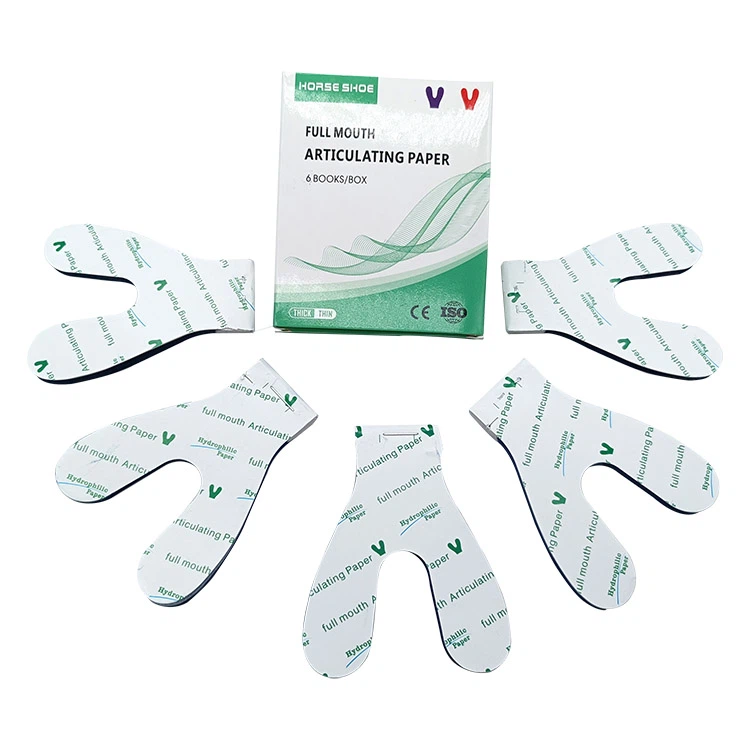
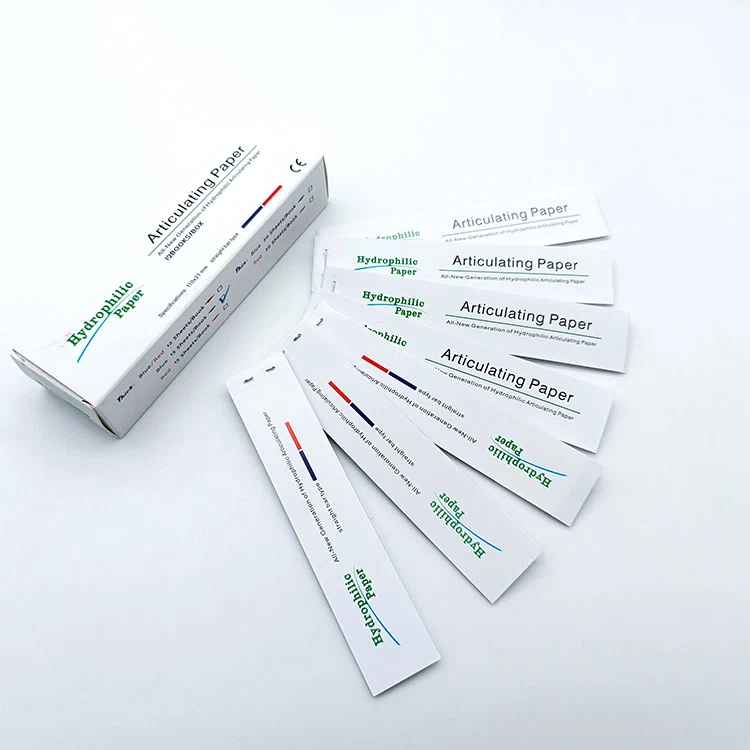
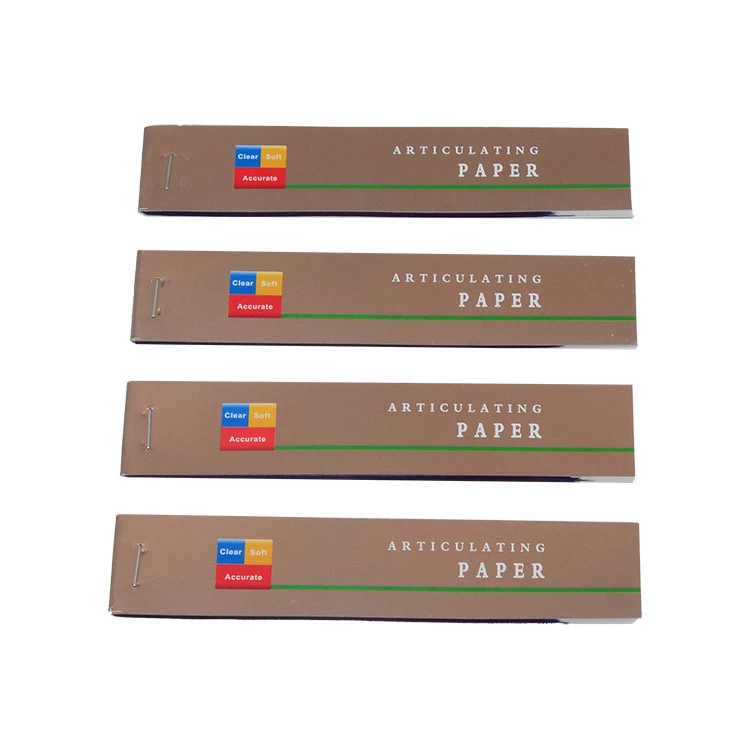
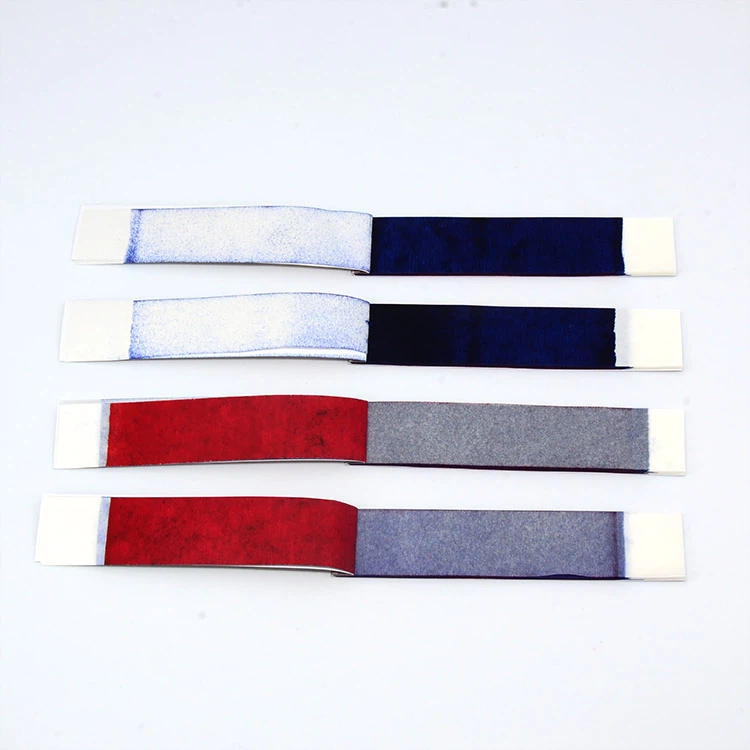
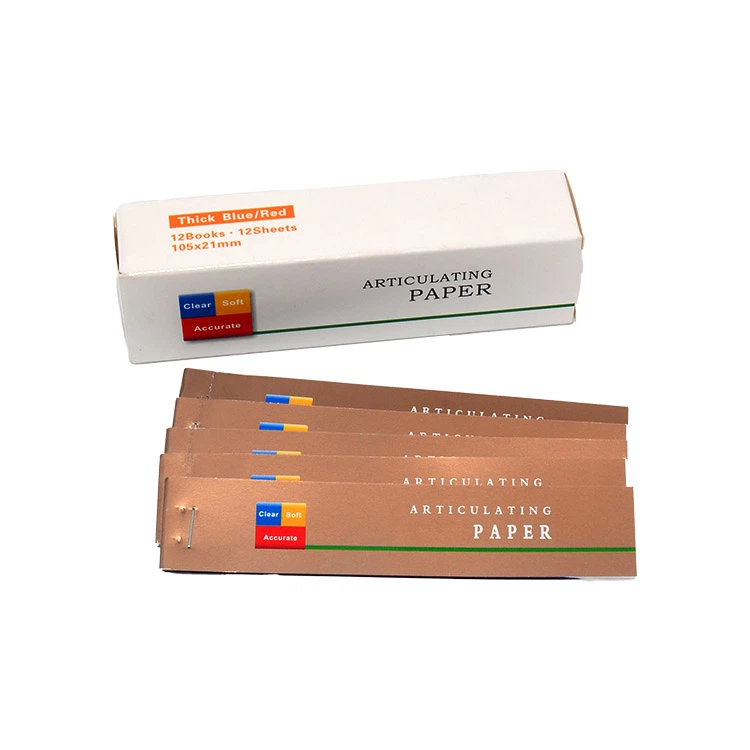
Articulating Paper
- Soft, smooth, nonsticking, sensitive surface for marking at every point of articulation
- Articulating paper available in straight, curved, curved with tabs and horseshoe
- Combined use of articulating film, foil and paper to mark high and low occlusion points provides the most accurate way to mark every point of articulation
Articulating paper is a reliable tool to assess and adjust occlusion,it’s used to mark and identify contact points between the maxillary and mandibular teeth during all forms of natural tooth occlusal adjustments and dental prosthesis insertions.
We offer articulating paper contain Thick Blue, Thick Red/Blue, Thin Blue, & Thin Red. Choose from a range of thickness levels to meet your clinical needs, ensuring accurate articulation on different tooth surfaces and restoration materials, and making the diagnostic process efficient and patient friendly.
Category
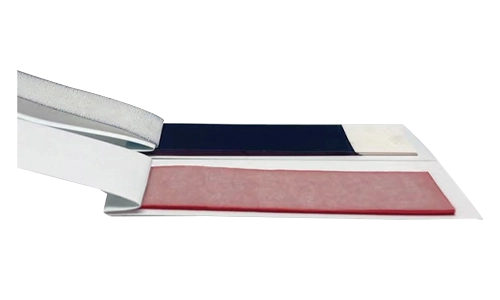
| Straight Shape | Package Shape |
|---|---|
GD-7001 100μm double color | 12 sheets/book, 12 books/box |
GD-7002 100μm blue color | 15 sheets/book, 12 books/box |
GD-7003 100μm red color | 15 sheets/book, 12 books/box |
GD-7004 50μm blue color | 20 sheets/book, 12 books/box |
GD-7005 30μm red color | 20 sheets/book, 12 books/box |
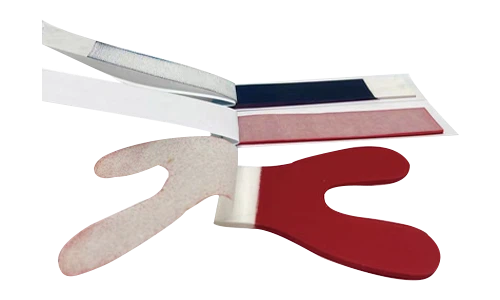
| Horse Shape | Package Shape |
|---|---|
GD-7006 100μm double color | 12 sheets/book, 6 books/box |
GD-7007 100μm blue color | 20 sheets/book, 6 books/box |
GD-7008 100μm red color | 20 sheets/book, 6 books/box |
GD-7009 50μm blue color | 30 sheets/book, 6 books/box |
GD-7010 30μm red color | 30 sheets/book, 6 books/box |
Articulating paper have high sensitivity, allowing for precise and clear marking of occlusal contact points during dental procedures.
Our articulating paper efficiently transfer color to contact points, leaving a lasting mark that aids in occlusal adjustments. Engineered with high-quality pigments and thickness levels to meet a variety of clinical needs.
What is dental articulating paper?
Imagine taking a bite out of an apple, and the moment your teeth make contact, how do you know which tooth is “pushing too hard”? That’s where dental articulating paper comes in. The articulating paper is essentially a copy paper with a special dye that marks the hot spots of pressure when teeth bite, usually red or blue. When the patient bites into the paper, it leaves color marks on the teeth. The dentist can then use these marks to determine areas of over- or under-bite and then adjust the shape of the restoration or orthodontic appliance.
Articulating paper can generally be made in different thicknesses depending on the material. Paper with thicker fibers is generally used to make thicker occlusal paper (200μm-40μm). Metal films can be very thin, and articulating paper below 40μm is generally made of metal films.
See the table below for details:
| Thickness | Material |
| 200μm | Paper |
| 100μm | Paper |
| 80μm | Silk/Paper |
| 40μm | Paper |
| 16μm | Polypropylene Film |
| 12μm | Metal Film |
| 8μm | Metal Film |
Three core roles of articulating paper:
1. Finding problems:
uncover over/under tooth contact points like a detective. Occlusal paper visualizes occlusal stress points through stained markings. According to these stress points, you can judge whether the bite is normal or needs to be polished or adjusted.
2. Balance adjustment:
Different color depths of marks reflect the amount of occlusal pressure. For example, darker areas represent concentrated pressure, while lighter or unmarked areas indicate inadequate occlusal contact. This provides visual data for the dentist to use when polishing crowns or fillings, allowing the dentist to create a crown with a normal occlusal and pressure balance.
3. Prevention of Hidden:
Diseases: Some people have a malocclusion due to tooth wear or trauma. Long-term malocclusion eventually leads to crooked face and headache. It is important to visit your dental office regularly for an oral checkup, which includes a bite test with articulating paper. If a bite problem is found it can be detected early and treated in time to prevent hidden problems.
Selection of paper thickness
- Thick articulating paper (≥40μm): It is generally made of paper, and its dye is distributed in the fibers of the paper. Once under pressure, the dye is released, forming an imprint. Therefore, the marks on thick articulating paper are continuous.
- Thin articulating paper (≤ 20 μm): This ultra-thin articulating paper is made of a metal film, and its dye is applied to the surface of the film. Sufficient pressure is required to form an impression. The impressions on thin articulating paper are either point-like or linear. In comparison, the impressions on thin articulating paper are displayed more precisely. If the impression is not obvious, when using it, you need to move your teeth slightly so that there will be a distinct impression on the articulating paper.
Characterization of the impression according to both thick and thin articulating papers. For the regrinding of Intercuspal position (ICP) occlusion, it is necessary to choose a variety of thicknesses of articulating paper, which gradually becomes thinner, from 200 μm to 40 μm, and finally 8 μm. For the regrinding of functional movement occlusion, it is possible to choose thicker articulating paper of 200 μm or 100 μm, which is better at eliminating occlusal interferences.
Procedure for articulating paper
- Have the patient bite on the blue articulating paper (200 or 100 μm) and repeatedly perform apical staggered bites, anterior movements and lateral movements. All contact points during functional movements and the occlusal contact points of the apical staggered bite will be colored blue.
- The red articulating paper (40 μm) was changed and the patient was allowed to bite at the ICP, the occlusal contact points at the ICP were stained red again, while the contact points during functional movements remained blue.
- The staining of the tooth surface allows the site and extent of occlusal contact to be determined, thus detecting possible occlusal interference. In the case of complex movements, occlusal contact can be examined with several different colors of articulating paper for different movements.
Summary of articulating paper impressions
- The thinner the paper, the smaller the occlusal impression area and the finer the occlusal relationship can be adjusted.
- Pay attention to the shape of the occlusal paper impression, do not only use the depth of the occlusal impression as a reference for adjustment.
- Anterior extension and lateral movement during occlusion adjustment, blue color records dynamic and red color records static.
- The change in the impression of the neighboring teeth during the occlusal adjustment is of some reference value.
Limitations of articulating paper
- Insufficient accuracy
Unable to quantify the size of the occlusal force, only a rough judgment of the contact strength through the depth of the impression, and is greatly affected by oral humidity. - Technical sensitivity
Operator maneuvers (e.g., occlusal pressure, speed of movement) may lead to differences in results, and reproducibility is low. - vs. Occlusal Analyzers
Occlusal analyzers (e.g. T-Scan) provide detailed quantitative data, but are costly and the sensors are easily worn out.
FAQs
Thick paper (e.g. 100-200 μm) is used to quickly locate the contact points during the initial occlusion adjustment phase, and thin paper (e.g. 40 μm-8 μm) is used to optimize the uniform contact during the fine adjustment phase. Thick articulating paper is preferred for the functional movement check in order to eliminate occlusal interference points quickly.
The occlusal status is differentiated by different colors (e.g. blue for functional movement occlusal points, red for median occlusal points). The areas where the colors overlap are normal contact points and do not need to be adjusted, only the blue markings need to be ground to eliminate interference.
It is not possible to quantify the occlusal force, only a rough judgment of the strength is made by the depth of the impression. It is affected by oral humidity, manipulation (e.g., bite pressure or speed of movement), and has low reproducibility.
- Judgment of abnormality: The incisal ridge of a single tooth in anterior extension movement is too deep and the neighboring teeth are not colored (blue zone), which suggests too early contact.
- Adjustment order: follow the principle of “thick to thin”, first use thick paper to eliminate occlusal interference, then use thin paper to optimize uniform contact.
The flatness of articulating paper, which directly affects the test results, should be stored in a dry and cool environment. Avoid direct sunlight and moisture to ensure that the articulating paper remains flat.

